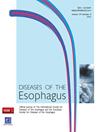503. HEALTH-RELATED QUALITY OF LIFE FOLLOWING CURATIVE INTENT TREATMENT FOR ESOPHAGEAL CANCER: IMPACT OF TREATMENT PATHWAY ON PATIENT-REPORTED OUTCOMES IN SURVIVORSHIP
IF 2.3
3区 医学
Q3 GASTROENTEROLOGY & HEPATOLOGY
引用次数: 0
Abstract
Background Recent improvements in treatment modalities for esophageal cancer have resulted in improved survival outcomes, and optimisation of health-related quality of life (HR-QL) in survivorship is now an increasing focus. This study aimed to compare HR-QL in survivorship following treatment with definitive chemoradiation (dCRT), neoadjuvant chemoradiation and surgery (nCRT), neoadjuvant chemotherapy and surgery (nCT), and surgery only (S). Methods This was a cross-sectional study of patients who underwent oesophageal cancer treatment between 2010 and 2021. A multicomponent questionnaire was distributed to disease-free patients at least one year post completion of treatment. Scores were calculated according to the European Organisation for Research and Treatment of Cancer manual. A mean difference of ten points or more for symptom and function scales was considered clinically significant. One-way ANOVA was performed to detect statistically significant differences between treatment groups. Results Some 125 patients were included. Global HR-QL was similar between treatment groups (mean±SD, dCRT 67.4±20.9, nCRT 71.5±19.6, nCT 80.0±15.0, S 69.0±20.0, P=0.265). Analysis of functional scales found lower emotional functioning (S 71.1±25.5 vs dCRT 87.1±15.6, nCRT 79.6±19.5, nCT 88.9±26.3, P=0.028) and body image scores (S 71.8±29.2 vs dCRT 87.9±22.5, nCRT 83.3±27.8, nCT 91.1±19.8, P=0.056) among patients treated with surgery only. Dysphagia (P=0.034), trouble with coughing (P=0.014) and choking when swallowing (P=0.018) were increased following dCRT as compared with surgical treatment. Following surgical treatment, patients reported more diarrhoea as compared with dCRT (P=0.020), while dCRT was associated with increased constipation (P=0.004). Conclusion Overall HR-QL was similar between groups, but distinct patterns of symptoms were observed in different cohorts. Symptoms related to swallow function were more common in patients treated with dCRT, while patients who underwent surgery exhibited more diarrhoea, possibly reflective of increased dumping syndrome. Interestingly, patients who received surgery upfront reported lower scores for emotional functioning and body image in the long-term after treatment, as compared with other groups. Further research is needed to determine the differential psychological impact of major resectional upper GI surgery among patients presenting with early stage versus locally advanced disease.503.食管癌根治性治疗后与健康相关的生活质量:治疗路径对患者报告的生存结果的影响
背景食管癌治疗方法的最新改进提高了患者的生存率,而优化患者生存期的健康相关生活质量(HR-QL)也日益受到关注。本研究旨在比较明确化放疗(dCRT)、新辅助化放疗和手术(nCRT)、新辅助化疗和手术(nCT)以及单纯手术(S)治疗后的生存期健康相关生活质量(HR-QL)。方法 这是一项横断面研究,研究对象为 2010 年至 2021 年期间接受食道癌治疗的患者。研究人员向治疗结束后至少一年无病的患者发放了一份多成分问卷。得分根据欧洲癌症研究和治疗组织手册计算。症状和功能量表的平均差异达到或超过 10 分即被认为具有临床意义。采用单因素方差分析检测治疗组间的统计学差异。结果 共纳入约 125 名患者。各治疗组的总体 HR-QL 相似(平均值±SD,dCRT 67.4±20.9,nCRT 71.5±19.6,nCT 80.0±15.0,S 69.0±20.0,P=0.265)。功能量表分析发现,仅接受手术治疗的患者情绪功能(S 71.1±25.5 vs dCRT 87.1±15.6,nCRT 79.6±19.5,nCT 88.9±26.3,P=0.028)和身体形象评分(S 71.8±29.2 vs dCRT 87.9±22.5,nCRT 83.3±27.8,nCT 91.1±19.8,P=0.056)较低。与手术治疗相比,dCRT 治疗后吞咽困难(P=0.034)、咳嗽困难(P=0.014)和吞咽时呛咳(P=0.018)增加。与 dCRT 相比,手术治疗后患者腹泻次数增多(P=0.020),而 dCRT 则导致便秘次数增多(P=0.004)。结论 各组的总体 HR-QL 相似,但在不同组别中观察到了不同的症状模式。与吞咽功能相关的症状在接受 dCRT 治疗的患者中更为常见,而接受手术治疗的患者则表现出更多的腹泻症状,这可能反映了倾倒综合征的增加。有趣的是,与其他组别相比,前期接受手术治疗的患者在治疗后长期的情绪功能和身体形象评分较低。要确定上消化道大部切除手术对早期和局部晚期患者的不同心理影响,还需要进一步的研究。
本文章由计算机程序翻译,如有差异,请以英文原文为准。
求助全文
约1分钟内获得全文
求助全文
来源期刊

Diseases of the Esophagus
医学-胃肠肝病学
CiteScore
5.30
自引率
7.70%
发文量
568
审稿时长
6 months
期刊介绍:
Diseases of the Esophagus covers all aspects of the esophagus - etiology, investigation and diagnosis, and both medical and surgical treatment.
 求助内容:
求助内容: 应助结果提醒方式:
应助结果提醒方式:


